News
Top 10 Popular French Fries Types: Secrets from Commercial Kitchens
The Origins and Global Evolution of French Fries
French fries are one of the most beloved snacks worldwide, with many people unable to imagine life without them. But have you ever wondered about their origins? The story of French fries dates back to the late 17th century in the Meuse River Valley, Belgium. During harsh winter months, locals, unable to fish, began slicing potatoes into fish-like shapes and frying them as a substitute for their usual catch. Over time, this innovation evolved into the familiar slender fries we know today.
The confusion surrounding their name stems from a linguistic misunderstanding during World War I. When American soldiers encountered the dish in Belgium, they mistakenly associated it with the French-speaking Belgian army, dubbing it “French fries.” This misnomer stuck, and despite Belgium's rightful claim as the birthplace of fries, the name persists globally.
The global spread of French fries as a fast-food staple was propelled by mid-20th-century fast-food giants like McDonald's. Their standardized production methods turned fries into a worldwide phenomenon. Today, French fries come in various types, textures, and recipes. In this article, we’ll explore the top 10 most popular French fry varieties, highlighting their unique characteristics and preparation methods. Ready to dive into the world of French fries? Let’s go!
TOP 10 Popular Classic & Creative French Fries to Transform Your Menu
Once you've learned about the origins of French fries, it becomes clear that this beloved snack has evolved into many different types around the world. As a snack owner or café operator, you might be tired of the regular types and are looking for ways to add variety and texture to your menu. If that's the case, the following list of the top 10 popular French fries will surely spark some inspiration for you.
From shoestring-thin fries that offer an ultra-crisp bite to luxurious truffle-infused varieties that cater to the refined palate, French fries have transcended borders and culinary traditions. Whether you are seeking to stay true to classic styles or explore innovative new twists, these different types of French fries can diversify your culinary offerings and captivate your diners. By learning how to make and present these unique fries, you can elevate your menu and keep your customers coming back for more.
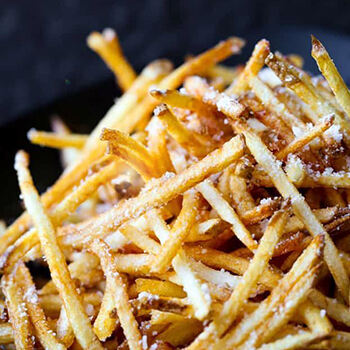
Shoestring Fries
Overview:
Shoestring fries, sliced into ultra-thin strips (3–5mm), are fried to a translucent golden color, with a glossy, slightly oily surface. When you bite into them, they produce a satisfying crisp "crunch," while maintaining a soft, tender core. Due to their delicate texture, they are often served as a side dish with premium steaks or used as a garnish for salads.
Ingredients: Russet potatoes, peanut oil.
Steps: Slice into matchsticks → Soak in ice water → Double-fry (160°C for 3 mins, 190°C for 1 min) using a Basket Fryer (shinelong 8L*2 2-Tank Electric Fryer) for consistent heat control.
Texture: Light, airy crispness.
Shape: 0.3cm thin, 8–10cm long.
Pairing: Truffle aioli or spicy sriracha mayo.
Julienne Fries
Overview:
These ultra-fine potato strands (1–2mm), resembling dragon beard candy, fry to a translucent amber color with slightly curled edges, creating a delicate crisp that shatters into fine crumbs. The subtle sweetness and smoky flavor make them a popular accompaniment in Vietnamese pho shops or Japanese izakayas, often paired with Asian-style sauces.
Key Points: The thickness of just 1mm requires quick frying (180°C for 90 seconds) to avoid excessive oil absorption.
Steps:
1. Use a professional slicer to cut the potatoes into thin strands and soak in saltwater to increase flexibility.
2. Fry quickly at 180°C until the edges curl, then drain and sprinkle with nori powder.
Texture: Delicate, glass-like crispness.
Shape: 1mm thin, 5–7cm long.
Pairing: Sweet chili sauce or wasabi cream.
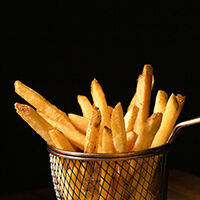
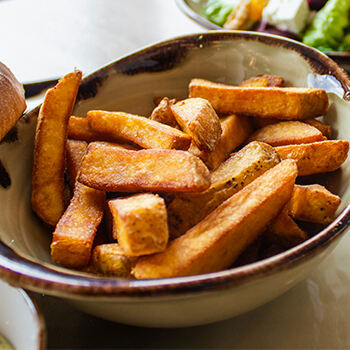
Steak Fries
Overview:
These hearty wedge-shaped fries (1.5–2cm thick) feature a deep brown crispy exterior with a soft, mashed potato-like interior. The steam rises with the comforting scent of starch when cut. Perfect for American steakhouses, they pair beautifully with rich sauces.
Key Differentiator: Pre-boiling to soften the interior before frying creates a crispy shell.
Steps:
Cut potatoes into wedges, leaving the skin on, and boil in water for 8 minutes until half-cooked. Fry at 170°C for 6 minutes (use a Shinelong dual capacity fryer for batch processing). Season with coarse sea salt and smoked paprika.
Texture: Crispy exterior, pillowy center.
Shape: 2cm thick, wedge-style.
Pairing: Béarnaise sauce or garlic herb butter.
Crinkle-Cut Fries
Overview:
The serrated edges create a textured surface, with crispy corners resembling cookies and the grooves holding onto oil, resulting in a golden-brown contrast. Their wavy shape makes them perfect for coating with seasoning, making them an ideal match for beer at sports bars.
Key Differentiator: The use of a wavy cutter to create grooves, followed by double frying and tossing with seasoning.
Steps: Cut potatoes into 1cm thick strips using a wavy cutter. Fry twice (160°C then 190°C), then toss in a seasoning shaker with cheese powder.
Texture: Crunchy ridges, tender core.
Shape: 1cm thick, wave-patterned.
Pairing: BBQ sauce or queso dip.
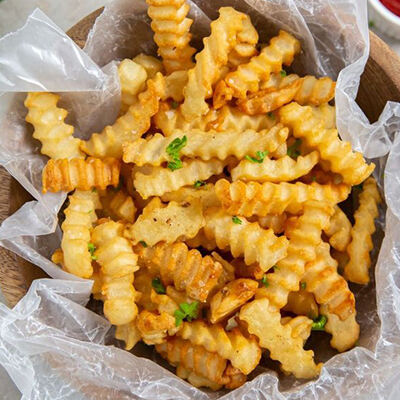
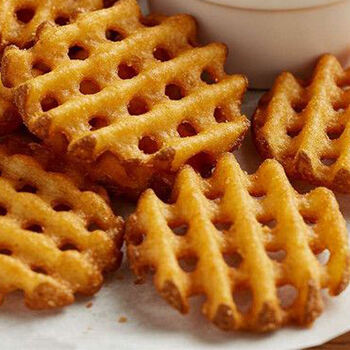
Waffle Fries
Overview:
Grid-shaped for optimal dipping, these fries thrive in casual eateries.
Steps: Waffle-cut → Fry at 175°C → Season with sea salt.
Texture: Crisp lattice, soft interior.
Shape: 1.5cm grid squares.
Pairing: Ranch dressing or jalapeño cheese.
Curly Fries
Overview:
Spiralized for whimsy, these crowd-pleasers dominate fast-food chains.
Key Tool: Spiralizer attachment.
Steps: Spiralize → Coat with seasoned flour → Fry at 180°C.
Texture: Crunchy curls with a hint of chew.
Shape: 0.5cm-wide spirals.
Pairing: Chipotle mayo or Cajun dip.

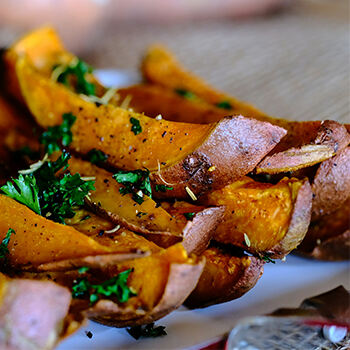
Sweet Potato Fries
Overview:
Sweet potato fries offer a healthier alternative with a natural sweetness that makes them a favorite in vegan and gluten-free menus. The vibrant orange color is visually appealing, while the crisp exterior and creamy interior provide a satisfying contrast. These fries are perfect for restaurants that focus on wholesome, nutritious food, especially when paired with fresh, natural ingredients.
Steps: Cut sweet potatoes into batons, toss with olive oil, and bake or air-fry at 190°C for a healthier option.
The baking or air-frying process ensures minimal oil absorption, resulting in a crisp texture without excess fat.
Texture: Crispy edges with a creamy, soft center.
Shape: 1cm thick, 10cm long, offering a substantial bite.
Pairing: Drizzle with a maple syrup glaze for added sweetness or serve with a creamy tahini dip for a rich contrast.
Belgian Fries
Overview:
Known as the originators of French fries, Belgian fries are double-fried for ultimate crispiness. The process, which involves frying in beef tallow, gives them an unmatched golden crust and a light, fluffy interior. These fries are a staple in Belgium, often served in paper cones with a variety of sauces, making them a great option for any commercial kitchen looking to elevate their fry game.
Steps: Cut potatoes into 1cm-thick strips. First, fry at 160°C to cook through, then let them rest. Second, fry at 190°C for that iconic crispy finish.
Pro Tip: Use a Shinelong thermostatic fryer for precise temperature control, ensuring each fry reaches perfection with even crispiness.
Texture: Golden, crispy crust with a light and fluffy interior.
Shape: 1cm thick, 10–12cm long, providing a perfect bite.
Pairing: Serve with Belgian mayo for authenticity or Andalouse sauce for a richer flavor experience.
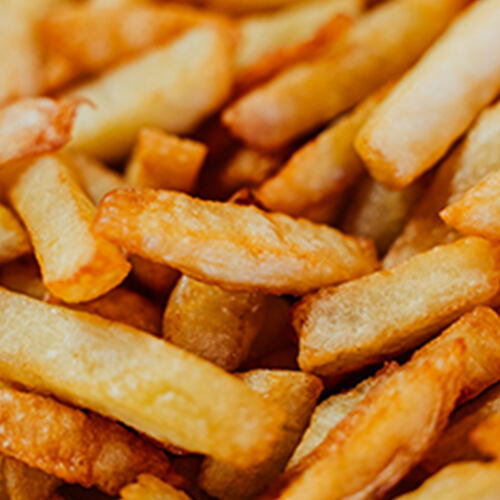
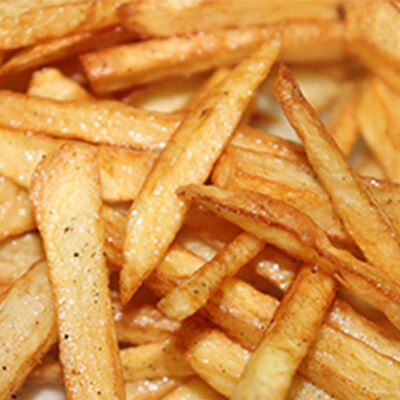
Hand-Cut Fries
Overview:
Hand-cut fries bring an artisanal, rustic appeal with their irregular shapes and sizes. They highlight the natural potato flavor, making them ideal for farm-to-table restaurants and eateries that emphasize local, fresh ingredients. The imperfections in the cuts lend a unique charm to each fry, with crispy edges and a hearty, satisfying interior.
Steps: Hand-cut the potatoes into varying sizes, soak them in vinegar water for 30 minutes to help crisp up the texture, then fry at 175°C. This soaking method helps remove excess starch and enhances the crispiness of the fries.
Texture: A crunchy exterior with a hearty, tender inside.
Shape: Irregular thickness ranging from 0.5–1.5cm, offering a rustic charm.
Pairing: Classic malt vinegar for a tangy punch or smoked paprika salt to add a smoky depth of flavor.
Truffle Fries
Overview:
Truffle fries are the epitome of luxury, often found in high-end gastropubs and restaurants. The earthy aroma of truffle oil combined with the rich umami flavor of Parmesan creates a gourmet experience. These fries elevate any meal with their sophisticated flavor profile and are a perfect choice for establishments looking to offer an indulgent twist on a classic favorite.
Steps: Fry shoestring fries until crispy, then drizzle with truffle oil. Finish by garnishing with freshly grated Parmesan and a sprinkle of herbs for an added depth of flavor. The key to great truffle fries is the quality of the truffle oil and Parmesan used.
Texture: Crispy fries with a rich, umami-packed flavor.
Shape: Thin, approximately 0.5cm, for that delicate crunch.
Pairing: Serve with truffle aioli to complement the truffle flavor or balsamic reduction to add a sweet tang.
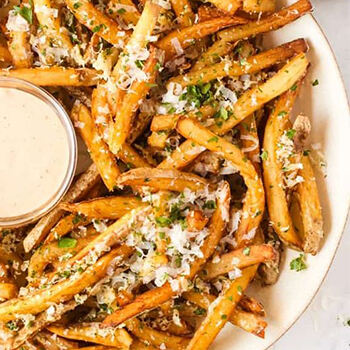
The Golden Rules for Perfect French Fries
Starch Treatment:
After cutting, rinse the potato strips until the water runs clear to remove excess starch. This step helps prevent sogginess and ensures a crispier texture.
Double Frying:
The first low-temperature fry cooks the potatoes through, making them tender. The second high-temperature fry crisps them to perfection, creating the ideal contrast between a soft interior and a crunchy exterior.
Oil Quality:
Use oils with high smoke points, such as peanut oil, to ensure frying at high temperatures without degradation. Regular oil filtration is also essential to maintain the oil's quality and prevent off-flavors.
Seasoning Timing:
Add salt immediately after frying while the fries are still hot. This ensures better adhesion, resulting in flavorful fries with evenly distributed seasoning.
Storage:
To maintain consistent quality, store cooked fries in a commercial freezer at -18°C. This helps preserve their texture and prevents them from becoming mushy when reheated. For optimal results, consider using the Shinelong refrigeration unit series, which is specifically designed for commercial kitchens. Whether you run a fast-food joint, a fine dining restaurant, or any other type of kitchen business, this series can help you manage your storage tasks more effectively.
These golden rules will elevate your French fries to restaurant-quality standards, perfecting the balance between taste, texture, and presentation.
This secret weapon makes your French fries stand out
Frequently Asked Questions
Q: What type of potatoes are best for making French fries?
A: Russet potatoes are the best choice for making French fries due to their high starch content, which results in a crispy exterior and fluffy interior.
Q: What type of oil is best for frying French fries?
A: High-heat oils with a neutral flavor, such as vegetable oil, canola oil, or peanut oil, are ideal for frying French fries.
Q: Can I eat French fries left out overnight?
A: No, it is not safe to eat French fries that have been left out overnight at room temperature.
 After-Sales:
After-Sales:
 EN
EN
 AR
AR
 HR
HR
 NL
NL
 FI
FI
 FR
FR
 DE
DE
 EL
EL
 HI
HI
 IT
IT
 PT
PT
 RO
RO
 RU
RU
 ES
ES
 TL
TL
 ID
ID
 SL
SL
 VI
VI
 ET
ET
 MT
MT
 TH
TH
 FA
FA
 AF
AF
 MS
MS
 IS
IS
 MK
MK
 HY
HY
 AZ
AZ
 KA
KA
 UR
UR
 BN
BN
 BS
BS
 KM
KM
 LO
LO
 LA
LA
 MN
MN
 NE
NE
 MY
MY
 UZ
UZ
 KU
KU









